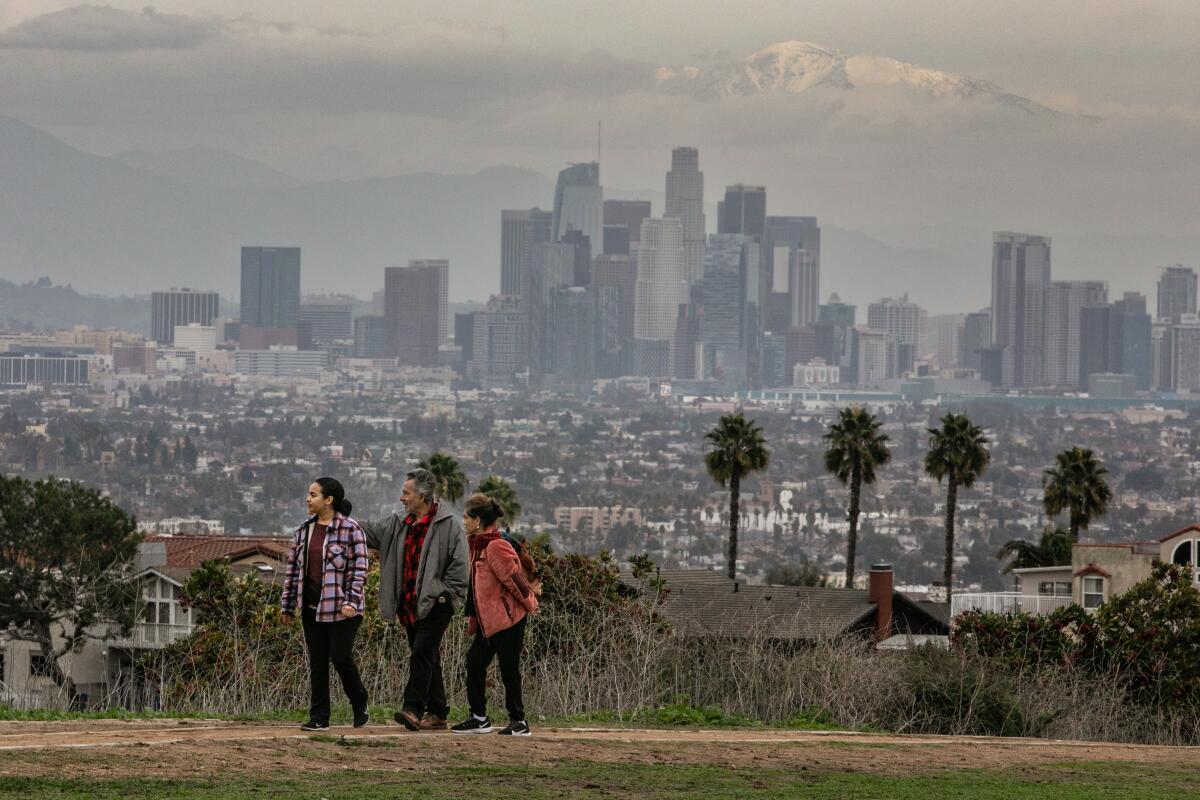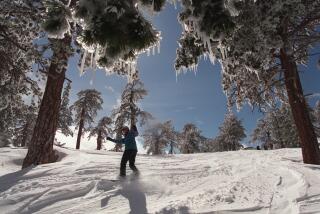Was it L.A.’s dreariest, gloomiest, wettest winter ever? Here’s what the numbers say

- Share via
Tourists at the top of Griffith Park on Wednesday morning got an accurate view of what it’s looked like to live in Los Angeles of late: gray as far as the eye could see.
It had been yet another stormy morning in a city synonymous with sunshine.
“I mean, listen, we need the rain, right,” said Addison Vincent, 30, who had just made the mud-slicked trek up to the top. “But it’s just a little excessive.”
On dreary days like this, Vincent said they usually stayed put in their Hollywood home — bingeing HBO’s “Succession” and watching their ferns and jade plants on the patio get irreparably drenched. It’s been mentally draining, they said, “bringing up a lot of melancholy and somberness.”
For many Angelenos, this winter felt like the gloomiest in recent memory. According to weather data analyzed by The Times, it really has been the drabbest winter Southern Californians have lived through recently.
Meteorologists will be quick to tell you there is no scientific definition of dreary. Unlike rainfall and snow depth, both carefully monitored by the National Weather Service, no TV forecaster is calculating just how often the weather made Angelenos feel like hiding under the covers.
But the National Weather Service does track the average sky cover between sunrise and sunset each day.
The Times analyzed four years of weather data recorded over downtown Los Angeles for January through March. The city saw about 15 more cloudy days this year compared with the previous years, the data show.
According to the National Weather Service, a day is considered cloudy when 80% or more of the sky is covered by clouds. A partly cloudy day is when cloud cover falls between 40% and 70% of the sky. Days where clouds cover less than 40% of sky are considered clear.
The cloudy spell is something sun-deficient Southern Californians likely already sensed.
One purveyor of light therapy lamps, which blast users with artificial light, says sales are up by 50% in Los Angeles compared with last winter. A salesperson at a Hollywood plant shop says they’ve seen more of their customers complaining of plants wilting from lack of sunlight — as well as those clearly left out in one too many rainstorms. Some health professionals say they’ve seen an uptick in patients experiencing common symptoms of seasonal affective disorder, a form of depression related to a change in seasons.
“It’s a lot of wanting to sleep more, having difficulty getting out of bed,” said Sierra Kuzava, a clinical psychologist at UCLA Health. “[People are] feeling like something is hanging over their head — because it is.”
There are a few reasons unrelenting gray days can wreak havoc on people’s mental health, she said. Lack of sunlight can disrupt people’s internal clocks, making them sleepy at the wrong times and dampening their mood. It can also decrease levels of serotonin, a chemical messenger that regulates mood, appetite and sleep. Plus, bad weather means plans for mood-lifting activities, like riding a bike or walking on a beach, get squashed.
Kuzava says she likes to remind her patients of one bright spot: the gray days are numbered.
“It can be really helpful to identify that there’s this link between the weather and how you’re feeling in part because it helps you recognize that you will probably feel better when the weather changes,” she said. “That alone can be helpful.”
One other way to quantify just how dreary it’s been: the number of rainy days that have forced people inside.
“It’s probably in the top 10 as far as gloomiest winters because of just how many stormy days we’ve had,” said National Weather Service meteorologist Ryan Kittell.
Kittell said downtown Los Angeles gets, on average, 29 rainy days in the six months between October and March. Between October 2022 and March of this year, there have been 46 days where it rained.
On only four other occasions have Angelenos endured more rainy days between October and March. The record was set in 1940-41, a particularly soggy period in Los Angeles history that saw it rain on 51 days.
Since October, 27.42 inches of rain have been dumped on downtown L.A., according to the National Weather Service. That’s more than the famously rainy cities of Portland, which has had 26.03 inches, and Seattle, which has had 22.50 inches.
Spencer Pennington moved from the outskirts of Seattle to Los Angeles in the fall of 2020. Unlike his perennially drizzly hometown, he says Los Angeles seems to break down during the downpours. Pennington said the hilly street in front of his Westwood home has routinely turned into a small river during the storms.
“This is like, ‘Blade Runner’-type L.A.,” he said. “It’s not like Randy Newman’s ‘I Love L.A.’ ”
But, residential torrents notwithstanding, he said he and Los Angeles natives tend to have diverging opinions on what exactly constitutes a gloomy day.
“I’m like, ‘This? This is mist! This is almost beach weather where I’m from,’ ” he said. “It’s culturally relative.”
More to Read
Sign up for Essential California
The most important California stories and recommendations in your inbox every morning.
You may occasionally receive promotional content from the Los Angeles Times.












